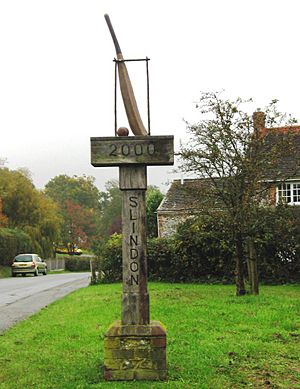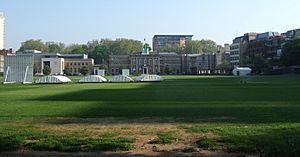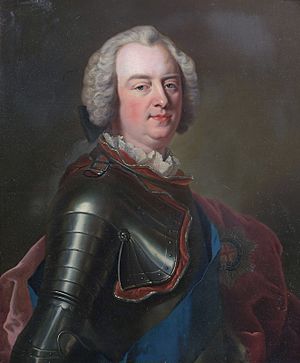Richard Newland (cricketer) facts for kids

Monument in Slindon village to commemorate its 1740s cricket team, including Richard Newland
|
|
| Personal information | |
|---|---|
| Full name |
Richard Newland
|
| Born | 1713 Slindon, Sussex |
| Died | 1778 (aged 64–65) |
| Batting | Left-handed |
| Role | All-rounder |
| Domestic team information | |
| Years | Team |
| c.1743 – c.1751 | Slindon Cricket Club |
| c.1743 – c.1751 | Sussex |
| c.1744 – c.1746 | Richard Newland's XI |
| c.1743 – c.1751 | England |
Richard Newland (born 11 September 1713 – died February 1778) was a famous English cricket player from the 1700s. He played for the Slindon team and for Sussex. He was supported by a powerful person called Charles Lennox, 2nd Duke of Richmond. Richard Newland also played for different England teams. Sometimes, he even led his own special team.
Richard was the oldest of three brothers who all played cricket. Many people think he was one of the greatest early cricket players. He is even called a "pioneer" of the sport. Newland was the first known left-handed batter in cricket history. He was known as a great all-rounder, meaning he was good at both batting and bowling. A famous poem by James Love even called him "The Champion." We don't know much about his bowling style, except that he used an underarm action, which was common back then.
Richard Newland played in at least 21 important matches between 1743 and 1751. In 1745, he scored 88 runs in one turn, which was the highest score anyone had made until the 1760s! He was also the uncle of Richard Nyren, who later became the captain of the famous Hambledon team. Newland is said to have taught his nephew how to play.
Contents
Richard Newland's Early Life
Richard Newland was born in 1713 in a village called Slindon, in Sussex, England. His parents were Richard Newland Sr. and Elizabeth Newland. They had ten children, and all of them were born in Slindon. Richard Sr. was a yeoman farmer, and Richard Jr. also became a farmer.
Two of Richard's younger brothers, John and Adam, also became well-known cricketers. One of his sisters, Susan, married Richard Nyren. Their oldest son, also named Richard, became the famous captain of the Hambledon team in the 1770s. It's believed that Richard Newland taught his nephew, young Richard Nyren, how to play cricket.
The first time Richard Newland was mentioned in cricket records was on 11 July 1743. He was the captain of an England team playing against Kent. This was a special three-a-side match at the Artillery Ground. At this time, he was about 29 or 30 years old.
Cricket Career Highlights
The Duke of Richmond's Support
Richard Newland's cricket career was greatly helped by the 2nd Duke of Richmond. The Duke loved cricket and used to captain his own team. But after he broke his leg in 1733, he couldn't play anymore. So, he put all his energy into supporting the Slindon Cricket Club. Slindon village was very close to his home, Goodwood House.
The Duke of Richmond was very dedicated to the Slindon team. In 1741, he wrote letters to his friend, the Duke of Newcastle, talking about Slindon's matches. For example, he wrote about a match where Slindon beat Surrey almost in one innings!
Newland's Skills and Fame
Newland was an all-rounder, which means he was good at both batting and bowling. He was the first known left-handed player in cricket history. We don't know much about his bowling style, but like all bowlers back then, he bowled underarm, meaning the ball stayed low to the ground. During the 1740s, many people thought he was the best and most famous player in England. He was even called "The Pioneer of Cricket."
People who gambled on cricket matches often bet on how many runs Newland would score because he was so good. In 1742, there were mentions of "the Sussex Man from Slending" and "the noted bowler from Slendon." While it's not certain, many believed these famous players were Richard Newland.
In 1743, Newland was officially recorded as one of the six players in a famous three-a-side match between England and Kent. The newspaper Daily Advertiser said these six players were "the best in England." Kent won that close match by only 2 runs. A huge crowd of about 10,000 people came to watch!
Matches and Rivalries in 1744

By 1744, Richard Newland seemed to have a friendly rivalry with another player named Robert Colchin, also known as Long Robin. They often picked their own teams to play against each other.
On 2 June, Newland played for a combined Surrey and Sussex team against London at the Artillery Ground. Surrey and Sussex won this game. This match is famous because it has the oldest known match scorecard in the world! It shows individual scores, but not how players got out.
Two weeks later, Newland played for England against Kent at the Artillery Ground. This match was celebrated in a poem called Cricket, An Heroic Poem (1745) by James Love. In this poem, Newland was called "The Champion" because he was so good at both single wicket and eleven-a-side games. Newland scored 18 not out and 15 runs in this match, which were the highest scores.
On 10 September, Slindon played against the London club and won. After their win, Slindon challenged "any parish in England" to play them. They quickly got challenges from the Addington and Bromley clubs. Richard Newland and Edward Aburrow were known to play for Slindon in these matches.
Newland's Top Score in 1745
After 1744, Slindon was mentioned less often, and Newland mostly played for England or led his own team, often against Colchin's team.
On 15–16 July 1745, Newland scored an amazing 88 runs for England against Kent at the Artillery Ground. This was the highest individual score ever recorded in cricket until the 1760s! It was an incredible achievement, especially because cricket pitches back then were very basic. This was also the earliest known half-century (score of 50 or more) in cricket history. England won this match and a prize of 1,000 guineas.
Later Years and Retirement
In 1746 and 1747, Newland continued to play in important matches, often against the best players in England. He was still considered one of the top players. In 1747, all three Newland brothers – Richard, John, and Adam – played together in a five-a-side match for Slindon against Dartford.
Newland's last known matches were in May 1751. He played in two matches for England against Kent and won both times. By then, he was 38 years old. It seems that after this, Richard Newland left the cricket scene and went back to his family's farm.
However, his influence on cricket continued through his nephew, Richard Nyren. Newland coached Nyren and taught him how to play. This was a very important gift to the sport, as Nyren went on to lead the Hambledon Club to great success in the 1760s and 1770s.
Richard Newland died in February 1778, when he was 64 or 65 years old. He was buried on 3 February 1778 in Slindon.
Images for kids





